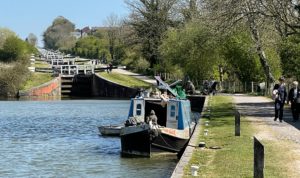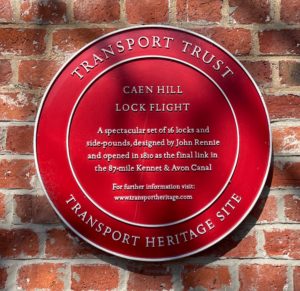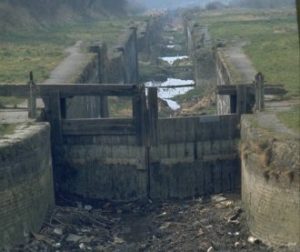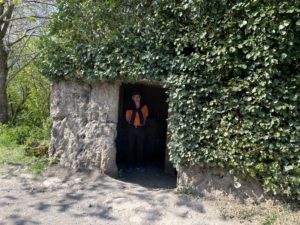In which Sid and Doris stop at Seend, wind the boat and walk up to the Caen Hill flight of locks.
From Semington to Seend is a little over two miles, with much incident in the way of swivel bridges and locks. We do not want to take Lydia up the Caen Hill flight of locks as it will take at least three hours, be very tiring and require us to turn around right away to come down again to get the boat home tomorrow.
At Seend we find a great couple minding the locks and we talk tactics. If we will just go up two more locks there is a large winding pool from which we come down one lock to moor by The Barge Inn pointing in the right direction for home. We get Lydia up into the winding pool and do a grand job of spinning round. The keepers are very complementary, then Sid lets the rudder touch the bank, and the tiller spins around so the handle is out over the water with Sid hanging on. Sid is not much evolved from his ape ancestors and the climbing muscles come into play. Sid stays dry. The rudder comes free, the tiller and Sid come back inboard and no-one has seen so no-one needs know, eh? [Sorry about the missed photo opportunity – Doris]
 We go back down, moor up, put our boots on and set off. The Caen Hill locks are a full hour on foot but they would have been two hours in the boat. And who would not walk an hour to see a flight of locks and a very worthy tea shop?
We go back down, moor up, put our boots on and set off. The Caen Hill locks are a full hour on foot but they would have been two hours in the boat. And who would not walk an hour to see a flight of locks and a very worthy tea shop?


 On the way up we admire the signs celebrating the effort of rebuilding the engineering marvel, bringing it back from a very sorry state of disrepair.
On the way up we admire the signs celebrating the effort of rebuilding the engineering marvel, bringing it back from a very sorry state of disrepair.
 On the way home we stop to interview a lady lock keeper (we could barely get a word in) who assured us that there is almost always someone to help with the flight, especially if you are a couple trying to do all the locks on your own. The trust has some paid staff on most days. So maybe next time. We also see what would probably be the perfect Bonkers house if we decide canal boating is the hobby of the future, combing en-suite boat parking with a very substantial garage.
On the way home we stop to interview a lady lock keeper (we could barely get a word in) who assured us that there is almost always someone to help with the flight, especially if you are a couple trying to do all the locks on your own. The trust has some paid staff on most days. So maybe next time. We also see what would probably be the perfect Bonkers house if we decide canal boating is the hobby of the future, combing en-suite boat parking with a very substantial garage.

 Walking back Doris spots a pillbox. In 1940 Britain had left most of its military equipment on the beach at Dunkirk so static defences were built to slow down the German advance. The canal was part of the GHQ line. Fortunately these fortifications were never tested. An 88mm shell would go through 200mm of steel armour. Bricks would have been dust.
Walking back Doris spots a pillbox. In 1940 Britain had left most of its military equipment on the beach at Dunkirk so static defences were built to slow down the German advance. The canal was part of the GHQ line. Fortunately these fortifications were never tested. An 88mm shell would go through 200mm of steel armour. Bricks would have been dust.
 The lock keepers had told us that though The Barge is on the river it is expensive and that the local pub is cheaper and just over in the village. The locals’ pub is for sale. We ask the serving girl what beer they have and she suggests San Miguel. We say What about brown beer? We think she has not drunk beer. She asks at the serving hatch and two local beers are brought. The Barge is probably popular for a reason.
The lock keepers had told us that though The Barge is on the river it is expensive and that the local pub is cheaper and just over in the village. The locals’ pub is for sale. We ask the serving girl what beer they have and she suggests San Miguel. We say What about brown beer? We think she has not drunk beer. She asks at the serving hatch and two local beers are brought. The Barge is probably popular for a reason.
And so our last night on the boat.